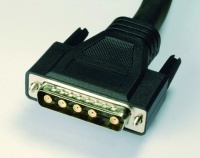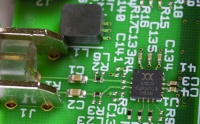
Over the past 10 years, the Camera Link standard has become widely acknowledged as the de facto means by which systems integrators interface cameras to computers in industrial vision systems.
Despite this, the standard is now beginning to show its age in terms of its inherent cost, its maximum 2-6 Gbit/sec speed bandwidth, and the 10m cable length restriction it usually places on systems developers.
Now, a new interface specification called CoaXPress has entered the frame that its developers — a European consortium comprising the Belgian fabless chip maker EqcoLogic, Dutch camera vendor Adimec and UK camera interface board developer Active Silicon — believe offers some significant advantages over the older Camera Link standard.
These European firms have also recently been joined in their efforts to back the new specification by two Japanese firms — AVAL DATA, a manufacturer of interface boards, and NED, a maker of line scan cameras — who are providing an independent route to market for the technology in Japan.
Unlike the Camera Link interface, which transmits data over a digital cable interface using SERDES interface ICs from companies such as National Semiconductor, the developers of the CoaXPress specification have based their interface on a less-expensive coaxial cable.
Using ICs from EqcoLogic, this has enabled the consortium not only to match, but also to exceed, the high speeds offered by the Camera Link standard, as well as allowing system integrators to build systems that cable up cameras to computers over a 100m distance.
The CoaXPress interface transmits data and control signals over the coaxial cable. While a high-speed channel from the camera to camera-computer interface transfers data at rates between 1.25 and 6.25Gbit/sec, a low-speed uplink provides a 20Mbit/sec means to supply important triggering and synchronisation information to the camera. Up to 13W of power is also delivered to the camera from the computer over the same cable.
EqcoLogic currently offers two devices to enable designers to build peripherals that are compatible with the CoaXPress interface. One is used in the camera to drive the high-speed data and one sits in a computer interface board to receive the high-speed data, as well as provide a means to transmit low-speed control data to the camera. Because they are built in a CMOS (complementary metal-oxide semiconductor) technology, both are low power (<70mW) products that can operate from a 1.2V supply.
’We are developing two versions of the CoaXPress interface, once of which will be an inexpensive “base” version and one will be a slightly more expensive “full” version,’ explained Chris Beynon, technical director of UK-based Active Silicon. ’The base version will operate at between 1.25Gbit/sec and 3.125Gbit/sec, while the full version will operate between 1.25Gbit/sec and 6.25Gbit/sec.’
The difference in price between the two versions will be due to the difference in speed at which the silicon interface devices from EqcoLogic run in the base or full configurations.

Despite the fact that the interface allows designers to upgrade their vision systems to speeds of more than 6Gbit/sec, Beynon feels that since 95 per cent of cameras in the machine-vision market presently operate at up to 3.125Gbit/sec speeds, many manufacturers are initially likely to embrace the lower-speed incarnation of the CoaXPress specification. Even so, the consortium has plans to allow developers to build systems that run at bandwidths even faster than 6.25Gbit/sec. ’Although we are limited to 6.25Gbit/sec using one coaxial cable, using more cables allows the interface to accommodate higher bandwidths. We have already shown a five-way cable supporting 31.25Gbit/sec. Although widespread demand for camera-based computer systems that run faster than 6Gbit/sec may be several years away, CoaXPress will accommodate these speeds as the bandwidth of cameras increases,’ Beynon said.
One of the key features of the EqcoLogic chips is that they can dynamically compensate for the different attenuation properties of the many types of coaxial cable that might be used by vision system developers.
’Because the real-time adaptive analogue equalisers in the chip set continually work out the attenuation patterns of the cable, they can compensate for any changes in the attenuation characteristics of the cable that might be due to factors such as temperature,’ Beynon said.
The specification has other advantages over its older Camera Link counterpart too. One of which is that it supports Cyclic Redundancy Checking (CRC) to ensure the integrity of the image data as it is being transferred from the camera to computer. A widely used technology, CRC is simple to implement in hardware and a good means to detect common noise errors. ’However good a cable is after months or years of use, it may start to fail, especially in applications where the cable flexes during use, such as on a robotic arm. But because the CoaXPress specification also supports the use of bit error rate testing (BERT), errors can be flagged before a cable fails catastrophically,’ said Beynon.
The other advantage of the specification is that it allows a frame grabber to send a trigger to the camera with a fixed delay of 3.4 microseconds with only a 4 nanosecond jitter. That’s important, Beynon says, because, as a result, the system can trigger a camera up to a speed of hundreds of kilohertz, which is, he claimed, beyond the capabilities of any line scan cameras that are currently on the market.
The Consortium does not plan to make the CoaXPress interface a proprietary standard — its goal is to make it an open standard by working with International Standardisation bodies. To do so, it passed the completed specification of the interface to representatives of the Japan Industrial Imaging Association (JIIA) in December 2009 who are now working to produce a formal standard.
For their part, the other two major standards organisations — the US-based Automated Imaging Association and the European Machine Vision Association — have also been invited to adopt the specification by the consortium once it has been ratified by the JIIA.
CoaXPress has already received an accolade from judges at the VISION 2009 show in Stuttgart. It won the ’Vision Award’ — a prize awarded to the most innovative technology at the show. The use of the single cable combined with the distance and speed the interface operates at were cited as the key reasons for the judges’ decision.
Although production shipments of any cameras or frame grabbers based on the specification are not likely to start until Q1 this year, Beynon said that Active Silicon has already received positive feedback on the interface from its customers.




Glasgow trial explores AR cues for autonomous road safety
They've ploughed into a few vulnerable road users in the past. Making that less likely will make it spectacularly easy to stop the traffic for...